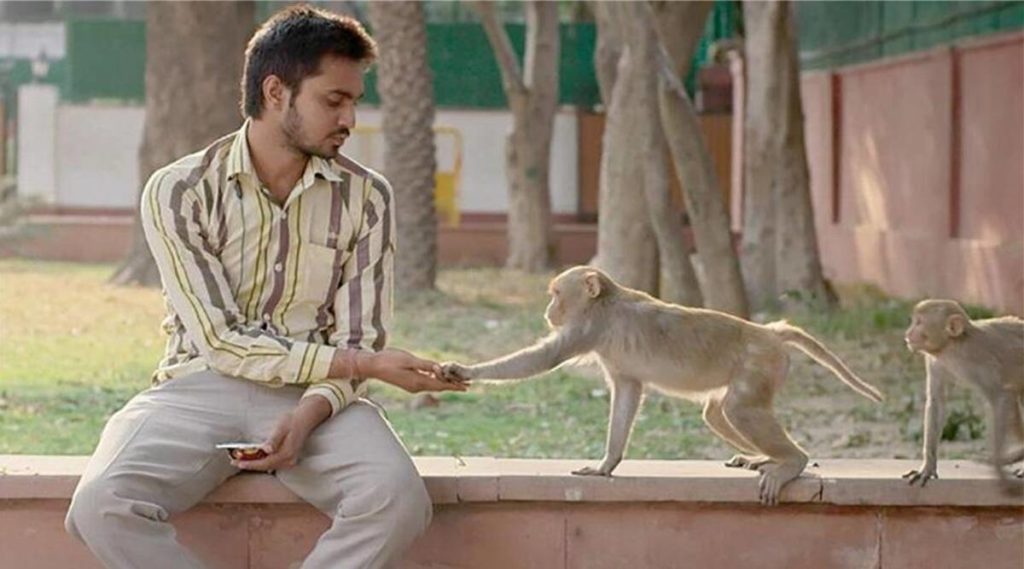Eeb Allay Ooo ”“ Bridging gaps through cinema

By Neeru Saluja
Even in the expanding landscape of alternative cinema emerging from India, Eeb Allay Ooo, written by Film and Television Institute of India alumni Prateek Vats and Shubham and directed by Vats, stands out as different. Combining social realism in contemporary Delhi, with equal dashes of satire, absurdism and a sensitive approach to issues faced by the working class, the film is also notable for the various institutions it has negotiated in production (National Film Development Corporation, or NFDC), reception (such as winning the Filmfare Award for Best Film (Critics), 2021) and screening (various festivals and currently screening on Netflix).
The protagonist of the film is Anjani (Shardul Bharadwaj), to whom the lure of employment in the city has led him to a contractual stint, a strange job in a strange place, while he stays with his sister (Nutan Sinha) in her small home. Over the course of the film, we accompany Anjani through dehumanising labour, the alienation in the city and the harnessing of discontent through ideology.
We talked to Prateek Vats about the process of making the film.

The subject of your film is very unique, how did you come up with it and is it based on a true story?
The trigger was a newspaper article that I read about five years ago. It didn’t turn immediately into a film. It took about four or five years to just soak it in and then I started working on a tangible script. This film is not based on a true story but the character is and he plays himself as a monkey repeller. It was important to have him onboard to understand the job profile as it’s a very unique job with it’s own set of peculiarities. The main narrative of the film is fictional.
The film not only revolves around monkey repellers but also touches on subjects like politics, religion and nationalism. How did you manage to weave all these issues in one story?
You are correct. As the director, I had to be careful on what issues I could integrate in the story. But as a person growing up in India right now, and particularly in a big city, these are the issues we are dealing with on a daily basis. It’s all about nationalism, religion and the level of exploitation the common man is facing. We observed what was happening around us and casually used these subjects as they were overlapping in the story. Randomly, these issues can also become life and death promoters.
Were there risks involved while shooting with monkeys?
Yes, of course. There was no training involved and the monkeys were not in captivity. And for us, it was important to shoot them in the film in a certain way just like we go so close to human beings to create the perfect vehicle for satire. Which meant we had to wait for that to work. We had to be really patient before we did scenes together. A lot of times, it was like approaching a documentary film. In the end, the most fun was exploring this different style of filmmaking.
While making the movie, did you draw similarities and differences between the behaviour of humans and animals?
I definitely wanted to work for the juxtaposition rather than trying to find commonality or similarity between them, and it was open to any kind of interpretation. There were lots of subtle hints, metaphors and humour in the film where the audience could create their own analogy.
Your film has won many awards and has been taken to many global festivals. How did the international audience react to this subject that only pertains to our society?
Initially I thought this film might only belong to our society, but the theme of contractual labour is quite universal. The fact is that this kind of nationalism is quite universal, in today’s day and age. Within the international audience, the discussions were not specific to monkeys or fundamentalism in India. It was about sorting these issues and our response to what is happening around us. To make this film work, it needed to be articulated like a satire or almost like a farce where the viewer feels as if it’s their own story.
These days there are lots of films made on issues the common person faces. But are these films reaching common people where OTT platforms may not be accessible?
I think that’s always been a struggle. These films are still viewed by only a small percentage of the whole population. To even get a distributor for this film took a toll on me. There is still a wide gap between independent filmmaking and mainstream cinema, but this film can be a case study that bridged this gap. This depends on factors like language, costs involved, screens available and many more. A lot of films tend to miss out on reaching a wider audience which otherwise could lead to some really interesting discussions.
Short URL: https://indiandownunder.com.au/?p=16842
